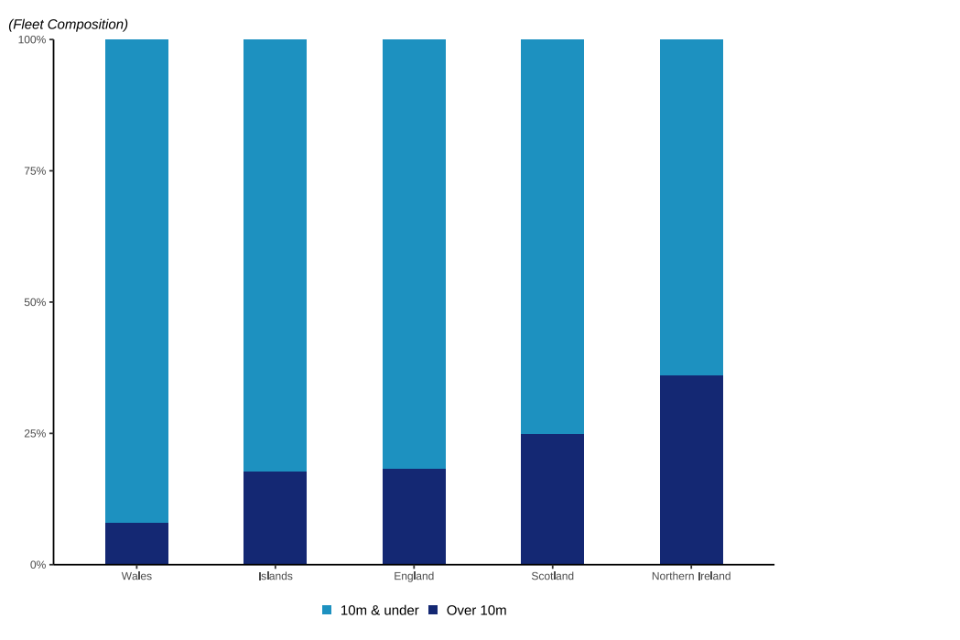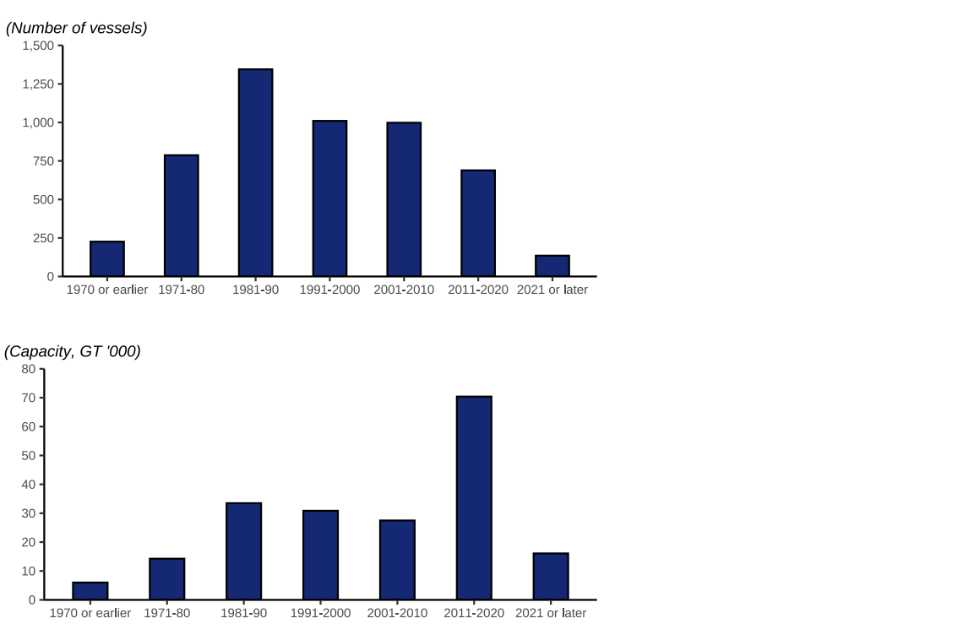Section 1 – Fleet
Updated 17 December 2024
1. Key Statistics - Fleet
In 2023 there were 5,418 UK registered fishing vessels. This represents a 54% reduction since 1993. The power (kW) of the UK fleet has also decreased by 42% over the past three decades. Gross Tonnage (GT) has decreased by 37% since 1996 when recording of this metric began, to 200 thousand tonnes. Approximately 79% of the UK fleet is represented by vessels under 10 metres in length, of which 49% are administered in England. The majority of UK vessels operate within the non-sector (87%) with the remaining vessels in membership of a Producer Organisation.
2. Section 1: Fleet
View the tables accompanying this section here.
3. Fleet Characteristics
Capacity and power
As well as the total number of vessels, the fleet can also be assessed in terms of their capacity and power. Capacity is usually measured in gross tonnage (GT) which is a volumetric measure of a vessel capacity. The power (kW) of a vessel refers to the vessel’s engine power.
The MMO holds data on the capacity and power of all individual UK vessels and these figures are aggregated to compare groups of interest. This allows for a more nuanced assessment of the fleet, as opposed to looking at the number of vessels alone.
The number of UK fishing vessels has reduced by 54% over the past three decades, from 11.7 thousand vessels in 1993 to 5,418 vessels in 2023. The power (kW) of the UK fleet has also decreased by 42% over the past three decades [4] . Two key changes which have contributed to this are national and international policies introduced to ensure the sustainability of fish stocks:
- Greater controls on fishing opportunities
- Fleet capacity reductions through decommissioning exercises
Figure 1.1 [5] [6] : Fleet characteristics split by country of administration within the UK.

In 2023, England contributed the highest number of vessels to the UK fleet, but Scotland’s fleet had more power and capacity. English vessels represent 48% of the total number of vessels in the UK while 9 Scottish vessels 37%. This proportion has remained the same since 2020, with little change over the last decade. The Scottish fleet has the largest contribution of capacity to the UK fleet (61%) while the English fleet accounts for 29% of the total fleet capacity.
4. Vessel length
Figure 1.2: Fleet composition showing proportion of over 10m and proportion of under 10m vessels by country of administration.

The Welsh fleet has the lowest proportion of vessels over 10m. The smaller number yet higher capacity of Scottish compared with English vessels (Figure 1.1) can be explained by Scotland having a higher proportion of larger, more powerful vessels in comparison to the English fleet.
The fleet with the largest proportion of vessels over 10 metres in the UK is the Northern Irish fleet. The different length composition of the fleet can again be used to explain why the Northern Irish fleet has more capacity and power than the Welsh and island fleets, despite having a similar number of vessels.
In 2023, there were 33 vessels that could not be assigned to a country. These vessels are registered but not administered by a port; typically, new vessels and vessels in the process of moving to another administration [7].
Fish stock
A fish stock refers to a fish population that is isolated from other stocks of the same species. For example, around the UK there are several cod stocks – including e.g. Cod 7d in the Channel and North Sea Cod. Many fish stocks are managed by quotas – limits set on the tonnage that can be caught. Currently the UK has quota for around 100 different fish stocks.
Owing to the diverse nature of the fishing industry, it is difficult to provide a simple explanation of the variation in fleet characteristics seen across each fisheries administration’s respective fleet.. The main influencer is the different fish stocks that the fleets target. Key elements of the Scottish fleet target several fisheries that are high volume but lower priced, such as herring and mackerel caught in the North Sea and West of Scotland waters. To target these stocks, the Scottish fleet has moved towards having higher capacity vessels which cover large sea areas and can catch large volumes (several hundred tonnes) of fish per trip.
Compared with this, the English fleet is involved in several key fisheries that are typically lower volume but higher priced, such as the Channel fisheries for sole and plaice. In addition, a greater proportion of the fisheries pursued by the English fleet cover inshore areas. Together these factors have allowed the English fleet to develop with a greater proportion of smaller vessels that are able to be economically viable through catching smaller quantities of more valuable fish. Changes in fishing opportunities over time have been key drivers for the development of the fleet.
Figure 1.3: Fleet characteristics by vessel length groups.

Larger vessels contribute more to the UK fleet’s capacity than smaller vessels. Vessels under 10 metres make up 79% of the UK fleet but only contribute 8% to the fleet’s total capacity. Larger vessels of more than 15 metres make up 10% of the total fleet by number representing 85% of the fleet’s capacity. This is because larger vessels utilise fishing gear that can catch larger quantities and hold greater amounts of fish per trip and can journey for longer distances to better fishing locations.
The Scottish fleet has larger vessels than the English fleet. The average length of a Scottish vessel is 11 metres, while the average length of an English vessel is just over 9 metres. As a result, the Scottish fleet has over twice the capacity than the English fleet, despite the English fleet having 21222% more vessels
5. Age of vessels
Figure 1.4: Fleet characteristics by age of vessels within the UK fleet.

Vessels built in 2011 or later have a much higher capacity than vessels built prior to 2011. While the number of vessels built since 2011 has decreased, the total capacity and power of those built since 2011 has increased substantially. These modern vessels (built since 2011) contribute 43% of the fleet’s capacity, while only making up 15% of the vessels in the UK fleet. In comparison, vessels built between 1981 and 1990 account for 25% of the total number of vessels in the fleet but only 17% of the fleet’s total capacity. This illustrates the transition within the UK fleet to fewer but larger vessels that have higher capacity and are more efficient in utilising the fishing opportunities available.
6. Industry Groups
Fish Producer Organisations (FPOs)
FPOs are officially recognised bodies set up by fishery or aquaculture producers. In the UK, they are responsible for managing the quota for their vessels and play an essential role in fisheries management.
On 31 December 2023, 695 vessels over 10 metres in length were members of a FPO, 64% of all vessels over 10m. The remaining 392 vessels over 10m were not members of an FPO and were therefore members of the non-sector. The proportion of non-sector vessels (36%) has remained relatively stable since 2018.
The composition of FPOs varies greatly; Scottish FPO had the highest membership with 134 vessels, although the average number of vessels in an FPO was 298 [8].
7. Fishermen’s survey
The MMO usually provides a summary of the estimated number of fishers working within the UK fleet collected from the annual Fishermen’s Survey. The data that was collected in relation to 2023 have been determined to be unreliable for English vessels, with the resulting estimates contrary to long term trends, coherent publications and anecdotal industry intelligence. Therefore, the results of the Fisherman’s Survey 2023 will not be published.
Data for 2022 and earlier continue to be the most reliable estimate of the number of fishers for UK vessels for that time period and have still been included within the published accompanying tables for this section. For analysis of the longer term trends please refer to last year’s release of UK Sea fisheries statistics 2022 [9] The number of fishers for Scottish vessels will continue to be published as part of the Scottish Sea Fisheries Statistics [10], and Seafish have published information about employment in the fishing industry in the Economics of the UK Fishing Fleet[11].
[4] Table 1.1.
[5] In this figure and throughout the publication, Islands refers to the Crown Dependencies of Isle of Man, Jersey and Guernsey.
[6] The figures and values reported here are based on the country of administration for the vessel while the figures in Tables 1.1 and 1.2 are based on the country associated with the district the vessel is administered by. Some Island vessels (based on country of administration) are assigned to England in the associated tables as the district of their admin port is Plymouth in England.
[7] Table 1.2.
[8] See Table 1.5.
[9] Section 1 - Fleet - GOV.UK.
